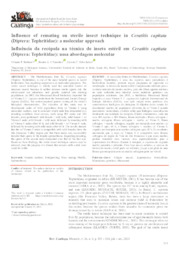Influence of remating on sterile insect technique in Ceratitis capitata (Diptera: Tephritidae): a molecular approach.
Influence of remating on sterile insect technique in Ceratitis capitata (Diptera: Tephritidae): a molecular approach.
Summary: The Mediterranean fruit fly, Ceratitis capitata (Diptera: Tephritidae), is one of the most harmful species to world horticulture, thus requiring suppression or eradication programs. The sterile insect technique is widely used for autocidal control of nuisance insects because it neither releases exotic agents into the environment nor introduces new genetic material into existing populations. In 2005, the Moscamed Brasil biofactory imported the tsl Vienna 8 C. capitata strain from the International Atomic Energy Agency (IAEA); this action required genetic testing of the strain?s biological characteristics. The objective of this study was to discriminate males of wild populations from tsl Vienna 8 using molecular markers, and to conclude which male line dominated in a remating condition. Four crosses, each using 100 males and 100 females, were performed: wild female × wild male; wild female × tsl Vienna 8 male; wild female × wild male, followed by remating with tsl Vienna 8 males after 48 h, and wild female × tsl Vienna 8 male, followed by remating with wild males after 48 h. The results showed that the tsl Vienna 8 strain is compatible with wild females from the São Francisco Valley region and that these males can successfully transfer their sperm to the female spermathecae. Regarding remating, the sperm of the second male dominated over that of the first one. Based on these findings, the sterile insect technique success may be reduced, since the progeny of a female that remates with a wild male could be viable.
Publication year: 2023
Types of publication: Journal article
Unit: Embrapa Semi-arid Region
Observation
Some of Embrapa's publications are published as ePub files. To read them, use or download one of the following free software options to your computer or mobile device. Android: Google Play Books; IOS: iBooks; Windows and Linux: Calibre.
Access other publications
Access the Agricultural Research Database (BDPA) to consult Embrapa's full library collection and records.
Visit Embrapa Bookstore to purchase books and other publications sold by Embrapa.

